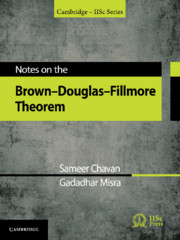Book contents
- Frontmatter
- Dedication
- Contents
- Preface
- From: The Evolution of Modern Analysis, R. G. Douglas
- Overview
- 1 Spectral Theory for Hilbert Space Operators
- 2 Ext(X) as a Semigroup with Identity
- 3 Splitting and the Mayer–Vietoris Sequence
- 4 Determination of Ext(X) as a Group for Planar Sets
- 5 Applications to Operator Theory
- Epilogue
- Appendix A Point Set Topology
- Appendix B Linear Analysis
- Appendix C The Spectral Theorem
- References
- Subject Index
- Index of Symbols
4 - Determination of Ext(X) as a Group for Planar Sets
Published online by Cambridge University Press: 30 June 2021
- Frontmatter
- Dedication
- Contents
- Preface
- From: The Evolution of Modern Analysis, R. G. Douglas
- Overview
- 1 Spectral Theory for Hilbert Space Operators
- 2 Ext(X) as a Semigroup with Identity
- 3 Splitting and the Mayer–Vietoris Sequence
- 4 Determination of Ext(X) as a Group for Planar Sets
- 5 Applications to Operator Theory
- Epilogue
- Appendix A Point Set Topology
- Appendix B Linear Analysis
- Appendix C The Spectral Theorem
- References
- Subject Index
- Index of Symbols
Summary
The first splitting lemma allowed us to split every extension [τ] in Ext(X) with respect to the closed cover ﹛A, B﹜ of X, where X = A ∪ B and A ∩ B = ﹛x0﹜. However, we will actually need a stronger form of splitting, one that allows any extension [τ] in Ext(X) to split with respect to the closed cover ﹛A, B﹜ of X such that A ∩ B is homeomorphic to a closed interval rather than a point. The precise statement is given at the end of first section (see Corollary 4.1.1).
Second Splitting Lemma
We begin with generalizations of Lemmas 2.2.1 and 2.2.2. The first one is attributed to von Neumann.
Lemma 4.1.1
Let be a finite dimensional subspace of and. If H is a self-adjoint operator, then there exists a finite dimensional subspace and a compact self-adjoint operator such that is reduced by and.
Proof The proof is a slight modification of that of Lemma 2.2.1. Assume that H is a self-adjoint operator. Let be a decomposition of σ(H) into a finite number of disjoint intervals of length less than and let
where E is the spectral resolution of H. Clearly, contains. For i = 1, …, N, let Ei denote the orthogonal projection of onto and. Note that H + K commutes with E. In fact,
Moreover, since E is of finite rank, K is compact. To complete the proof, we must check that. To see that, let be the mid-point of: Then,
and hence, we obtain
This completes the proof of the lemma.
Before we extend the last lemma to several compact self-adjoint operators, we formally define n-diagonal operator matrices.
Defnition 4.1.1
Let n be a non-negative integer and let for every integer. An operator matrix is said to be n-diagonal if for integers such that.
Remark 4.1.2 Note that 0-diagonal operator matrix is diagonal. Let be an integer. be a self-adjoint operator with operator matrix decomposition with respect to the decomposition. Then, is n-diagonal if and only if
for all integers
(see Exercise 4.6.1).
The following lemma ensures a decomposition of compact self-adjoint operators into an orthogonal sum of n-diagonal operators modulo compacts.
Lemma 4.1.2
For any compact self-adjoint operators in, there exist compact self adjoint operators in and an orthogonal decomposition into finite dimensional subspaces,… relative to which the operator matrix for is diagonal and that for is (n + 1)-diagonal,.
- Type
- Chapter
- Information
- Notes on the Brown-Douglas-Fillmore Theorem , pp. 117 - 146Publisher: Cambridge University PressPrint publication year: 2021

